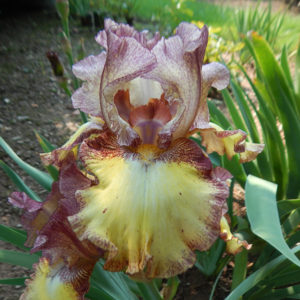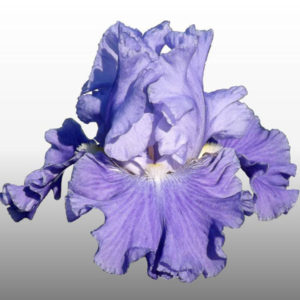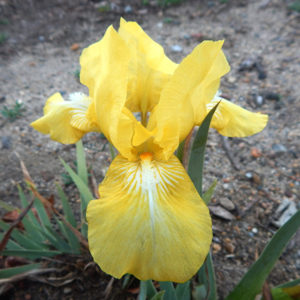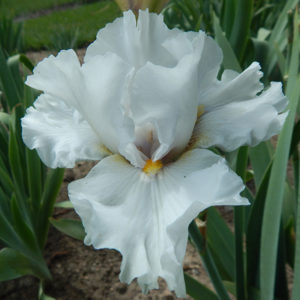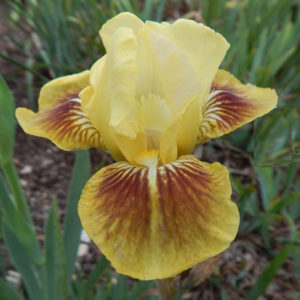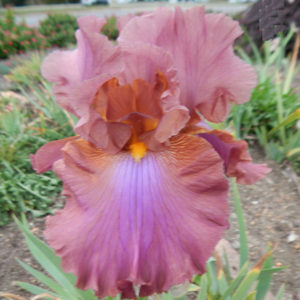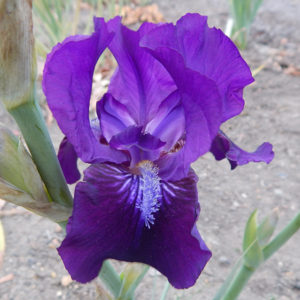Fall Rebloom Overcomes Fickle Weather in Central Virginia
by
Mike Lockatell
RIS Eastern Director
Weather conditions played an important role in affecting fall bloom results for reblooming bearded irises in Metro Richmond and Central Virginia micro-climates for 2021. Rain totals for August and September at first glance appear normal at 7.21” and 5.79” respectively. Upon closer examination, each month was dry with just a few days spiking the overall totals. The script did not change much in October. Precipitation amounted to 5.61” with two days 10/6 at (2.14”) and 10/16 at (2.51”) supplying most of the month's total.
Night temperatures in October were another major concern. Late September saw evenings below 60º F, but the following month had just a few days below the mark by 10/17. The twin impediments therefore may help explain puzzling delayed rebloom on many reliable varieties into early November. As usual, there are always exceptions to the baseline. Some seedlings in particular turned heads at my J. Sargeant Reynolds Community College (Goochland County, VA ) and BP Market (North Chesterfield, VA), display beds.
The JSRCC area was actually drier than most of the region. Little rainfall was recorded in Goochland County during summer and early fall. A few new seedlings did initiate short or stunted summer bloomstalks.
Lockatell BB Re 21221 did produce nice ruffled white median flowers in mid June. Lockatell TB Re 21438, a red plicata with yellow ground repeated its early September 2020 rebloom again in 2021 on two stalks. The parentage is (TB Re Echo Location (Wilkerson, 2007) X sib to BB Re Double Dare (Lockatell, 2014)). Flower quality improved, so this promising seedling will be closely watched in the coming year.
Two Lockatell tall bearded introductions turned in outstanding fall performances at JSRCC. TB Re Metro Blue (Lockatell, 2015) flowered from 9/30 to 11/14. It was the best ever fall rebloom for the moorish blue self in Goochland County, By the time Jack Frost arrived, there were ten bloomstalks in the clump with open blooms or color in the flower buds.
The TB Re Gate of Heaven (Zurbrigg, 2004) and TB Re Daughter of Stars ( D. Spoon, 2001) child has turned in consistent fall flowering in many micro-climates around the US. According to Scarlett Ayres Co-Chair for the upcoming AIS National Convention in Las Cruces, NM, “Metro Blue rebloomed everywhere October through December.” A special thank you to Howie Dash (Las Cruces) for posting a snow covered fall bloom in 2020.
TB Re Hidden Sky (Lockatell, 2021) made its debut in 2021. The hyacinth blue with a white area on each fall would commence a mid September rebloom sequence in previous years. The prevailing weather conditions led to a shorter rebloom period in 2021. The first Metro Blue child to be introduced, fall flowering lasted from 10/5 to 11/14 at JSRCC. The good news is more Metro Blue offspring either flowered or had developing bloomstalks this past fall at both JSRCC and BP Market.
Other tall bearded named varieties growing at JSRCC with notable fall flowering were TB Re Belvi Cloud (K. Jensen, 1988 and TB Re Liquid Amber (G. Spoon, 2003). Each selection bloomed from mid September to first frost in mid November. TB Re Just Call Me (Wilkerson, 2008), TB Re My Friend Jonathan (B. Miller, 1996) and TB Re Gate of Heaven (Zurbrigg, 2004) had significant fall rebloom on short bloomstalks.
SDB Re Baby Blessed (Zurbrigg, 1979) was tops amongest medians flowering from 10/3 to 11/14. The light yellow with white spot on each fall is still one of the best SDBs for cool season rebloom. Other medians with fall rebloom at JSRCC were MTB Re Lady Emma (FP Jones, 1986), SDB Re Rosalie Loving (D, Spoon, 2003) and MDB Re Trimmed Velvet (D. Spoon, 2006) had blooms from mid to late October ending with first frost in mid November.
Lockatell BB Re 21221 not only produced summer blooms, but the border bearded seedling resumed flowering on 9/20 lasting the entire rebloom season at JSRCC. The ruffled white with yellow shoulders and orange-red beards still had developing bloomstalks stopped by frost in mid November.
Another median seedling deserving mention was Lockatell SDB Re 21620-02Re. This reselect produced a viable bloomstalk in mid July and then began a second rebloom sequence with open blooms on 9/26 through 11/3. More developing bloomstalks were present before being cut down by the November 14th frost. Flowers are yellow with red thumbprint on each fall. Parents are SDB Rosalie Loving and Lockatell SDB Re 21068 or (SDB Re Sailboat Bay (Zurbrigg, 2004) X SDB Re Inner Space (Tasco, 2009).
My display bed at BP Market was established in 2013 to bring attention to cool season reblooming bearded irises at a major intersection on VA State Route 60 (Midlothian Turnpike) in South Richmond. By planting the best performing tall bearded and median named varieties, passing motorists and customers visiting the convenience store would notice and be encouraged to add these versatile heirloom perennials to their home landscape. By not being the primary business on the property, county government ordnances would not allow me to post any signs to bring attention to the reblooming irises in the planting.
This reality led me to use the display bed to test reselect and new seedlings for their fall flowering potential in a unique micro-climate. Thanks to asphalt surrounding the growing space along with the constant traffic flow on Midlothian Turnpike, air temperatures could stay above freezing in both November and December to initiate possible rebloom on medians,
Weather conditions in 2021 would support this contention. Even though frost ended most quality tall bearded rebloom in mid November, unseasonably warm daytime temperatures would eventually drive further median flowering in December ending with snow and bitter cold on January 3, 2022. Winter bloom at Christmas and New Year's Eve was an unbelievable sight for me.
Two tall bearded seedlings take the rebloom spotlight at BP. Lockatell TB Re 21424-9 was planted there in 2019. The fragrant diamond dusted white had already turned in encouraging fall performances at JSRCC starting in 2017. Despite dry conditions, 21424-9 began flowering on four stalks beginning on 9/26. Bloom finally ended on November 1st. The parents are TB Re Harvest of Memories (Zurbrigg, 1985) and TB Re Just Call Me. Rebloom hybridizers should take notice.
The other tall bearded hopeful to mention is Lockatell TB Re 21233 RB. It continues to produce flowers each fall with littlle care and watering. Rebloom began on 10/15 and stopped on 12/9 after a hard freeze. There were still viable bloomstalks with flower buds ready to bloom on January 3rd. The same seedling planted at JSRCC had flowering from 10/8 through 11/3 on multiple bloomstalks. The parentage is TB Re Northward Ho (Zurbrigg, 1991) X TB Wearing Rubies (Blyth, 2001-2002). This tall bearded blended red won “Best Seedlng in Show” at the Region 4 Fall Flower Show in 2019.
The best tall bearded cool season rebloom named variety at BP Market was TB Re Hidden Sky. Two clumps produced open flowers from 10/20 to 12/19 despite November and December frosts. The hyacinth blue grows well with little attention or watering. TB Re Belvi Cloud and TB Re Over & Over (Innerst, 2001) also turned in early flowering. TB Re Rosalie Figge (McKnew, 1993) and TB Re Unchained Melody (Mahan, 1999) chipped in November rebloom.
The best overall median performer at BP Market was SDB Re Baby Blessed. There is three clumps residing in the planting and rebloom was recorded from 10/9 until 12/29. There was still additional bloomstalks waiting to flower prior to the January 3rd snow and cold. MTB Lady Emma turned in a similar performance as Baby Blessed. The light yellow rebloomed on two clumps starting on 10/7 and lasting until December's end.
IB Constant Companion (Marsh, 1995) began its fall flowering in late October and continued to bloom until the new year. The two-tone red-violet flowered on two clumps in the back of the planting. Honorable Mention goes to SDB Re Forever Blue (Chapman, 1997), SDB Re Sailboat Bay (Zurbrigg, 2004) and SDB Re Smell the Roses (Byers, 1988). Each selection benefited from November and December warmth to produce open flowers. It was surely a nice show for BP Market customers to enjoy while the surrounding landscape had already fallen asleep.

